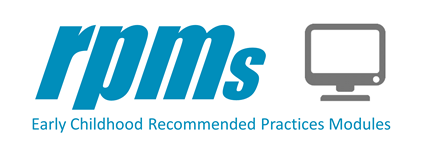Module 7: Assessment
Welcome to this Module on Assessment based on the Division for Early Childhood (DEC) Recommended Practices. In this module, you will learn effective assessment practices and why assessment is crucial for children with disabilities.
Learning Objectives
Completion of this module will enable you to:
- Explain what assessment practices are, and describe how they support children’s short-term and long-term goals.
- Describe key assessment principles to make optimal data-driven decisions related to intervention practices.
Each module developed by the Recommended Practices Module (RPM) project introduces and illustrates the practices grouped in one of the eight topic areas in the Division for Early Childhood (DEC) Recommended Practices. The DEC Recommended Practices were developed to provide guidance about the most effective ways to improve the learning outcomes and promote the development of young children, birth through five years of age, who have or are at-risk for developmental delays or disabilities.
Download: DEC Recommended Practices
Module 7 is aligned to the topic area of assessment and focuses on the following recommended practices:
Recommended Practices
-
A1. Practitioners work with the family to identify family preferences for assessment processes.
-
A2. Practitioners work as a team with the family and other professionals to gather assessment information.
-
A3. Practitioners use assessment materials and strategies that are appropriate for the child’s age and level of development and accommodate the child’s sensory, physical, communication, cultural, linguistic, social, and emotional characteristics.
-
A4. Practitioners conduct assessments that include all areas of development and behavior to learn about the child’s strengths, needs, preferences, and interests.
-
A5. Practitioners conduct assessments in the child’s dominant language and in additional languages if the child is learning more than one language.
-
A6. Practitioners use a variety of methods, including observation and interviews, to gather assessment information from multiple sources, including the child’s family and other significant individuals in the child’s life.
-
A7. Practitioners obtain information about the child’s skills in daily activities, routines, and environments such as home, center, and community.
-
A8. Practitioners use clinical reasoning in addition to assessment results to identify the child’s current levels of functioning and to determine the child’s eligibility and plan for instruction.
-
A9. Practitioners implement systematic ongoing assessment to identify learning targets, plan activities, and monitor the child’s progress to revise instruction as needed.
-
A10. Practitioners use assessment tools with sufficient sensitivity to detect child progress, especially for the child with significant support needs.
-
A11. Practitioners report assessment results so that they are understandable and useful to families.
